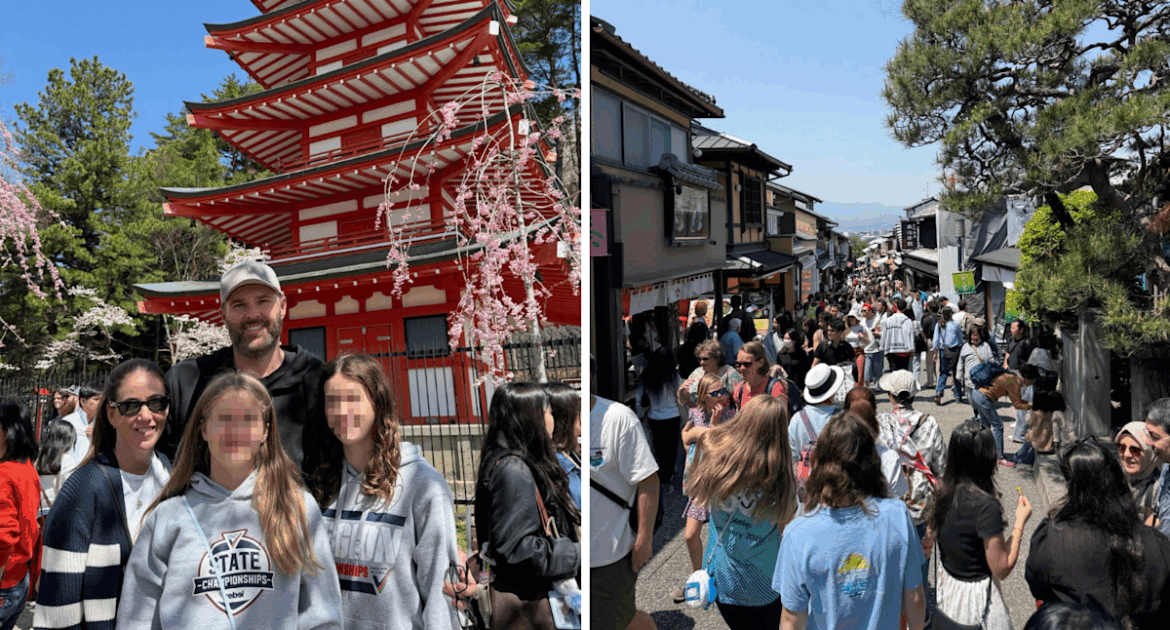When I read that a US tourist recently impaled himself on a metal fence while attempting to take a selfie at Rome’s Colosseum, I was horrified. At the same time, I wasn’t surprised.
Tourists behaving badly, disrespecting rules or the cultures and traditions of countries they are visiting, isn’t anything new. After a recent trip to Japan, I can say, if anything, it’s getting worse, highlighted by the example above, a man who was lucky to escape with his life.
Now, I’m unsure if the pandemic is to blame – perhaps the years of being unable to freely travel, or being locked down with restricted freedoms, have planted a nonchalant, disrespectful seed amongst the population when it comes to travel. Or perhaps it has exacerbated an issue that was already there. All I do know is, bad tourism is worse than ever. It is rampant, embarrassing, and for my family and me at least, has left a sour tinge on our recent travel experience.
You see, as we made our way around Japan for a three-and-a-half-week trip, we witnessed daily examples of this, some of which made me recoil. Many of these occurred in the city of Kyoto.
Arguably, visiting Kyoto, the place perhaps most significantly impacted by Japan’s over-tourism issue, could be an example of being a ‘bad tourist’ in itself (which I acknowledge). However, it’s nothing in comparison to the behaviour I observed while there and the unfortunate and seemingly necessary steps the city is taking to address the issue.
Honestly, I could probably write a book with examples I saw, but I’ll condense it to these.


Kyoto attracts thousands of tourists, and not all of them know how to behave. Credit: Shona Hendley
RELATED:
Shocking acts of bad tourism in Japan
One of the worst was while visiting a Buddhist temple in Kyoto’s city centre. Upon entry and throughout the precinct, there were clear signs in multiple languages and with illustrations asking visitors to keep their voices down, to not take photos in specific areas, to not sit on the stairs and to not eat or drink.
On this particular day, a wedding was taking place inside the temple, while undercover, it was fully visible to visitors. For me, this was a cue to be even more mindful of the rules; for others, it was the opposite- a time to grab some authentic footage.
Yep, I’m talking about approaching the area with phones held out, taking selfies with the bridal party in the background, using selfie sticks and tripods for an even better shot, and to top it off, wolf-whistling loud enough to distract the wedding guests from the proceedings.
But if this wasn’t enough, before leaving the temple, literally right in front of a sign that said do not sit on the stairs, was a man sitting on the stairs, while eating a snack (something else prohibited) he had pulled from his bag, and another who at the entry gate, decided to launch a drone.
Public transport also affected by badly behaved travellers
Along with temples and shrines, public transport seemed to be a bad tourism Mecca. There were multiple public transport rides where tourists would be having overly loud conversations on their mobile phone, often with the recipient on speaker, or even FaceTime. Or they would pull out food, including a hard-boiled 7-Eleven egg to consume, despite these things being well-known faux pas.
Because the Japanese people are so polite, they didn’t say anything, but it was evident from their expressions that they weren’t impressed. And rightly so.


The city of Kyoto has taken to putting up posters telling people how to behave respectfully while there. Credit: KYOTO CITY OFFICIAL TRAVEL GUIDE
Japan’s response to growing ‘bad tourist’ problem
Seemingly, in response to this sentiment, while in Kyoto, I came across a poster created by the City of Kyoto, which was plastered all around the city: the Mind Your Manners Poster.
On it are the dos and don’ts of visiting the city (respectfully), which include being quiet/ considerate, a reminder not to litter, not to smoke on public streets and not to use phones where prohibited (all things you would expect to be common sense).
Many of these requests have also been published via various Japanese tourism social media accounts, including this one from Japan.Tokyo.Official, which reminds visitors that Japan is NOT a theme park.
“It’s such a shame that a post like this is even required, we are after all guests when we visit Japan,” on one of the comments on the post reads. “Should be common sense that we don’t go climbing on a scared shrines.”
But perhaps the most telling indication of how paramount this issue is is something that happened as my family left another Kyoto temple one day. As we walked past two locals who were working for the City, we were asked to take part in a quiz, one that ultimately proved to be about how to be a good tourist, or what they called ‘touristship’- “like sportsmanship, but when travelling,” they explained.
While the quiz- which involved what to do and not do at temples – was pointless for my family, as aware, considerate, and respectful travellers who read up on the country and culture we visit before arriving and act accordingly, it is obviously a necessary action for many, many others and a response to a growing issue they are facing, an epidemic that paints all travellers in a bad light.
Want the latest lifestyle and entertainment news? Make sure you are following us on Facebook, Instagram and TikTok and don’t forget to subscribe to our newsletter.


AloJapan.com